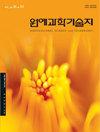Phenotypic Variations in External and Internal Fruit Quality Traits of Different Plum Accessions
IF 0.8
4区 农林科学
Q3 HORTICULTURE
Korean Journal of Horticultural Science & Technology
Pub Date : 2023-10-31
DOI:10.7235/hort.20230045
引用次数: 0
Abstract
Chinese plum (Prunus salicina Lindl.) is a fruit tree with a range of different fruit characteristics, such as different sizes, shapes, flavors, textures, and colors. The relationships between the economic characteristics, nutritional components, functional components, and antioxidant activities of plum fruit have rarely been reported. In order to select new and superior varieties of Chinese plum that are suitable for promotion in north China, eight Chinese plum varieties mainly cultivated in Henan Province (‘Purple amber plum’, ‘Green crisp plum’, ‘French plum’, ‘Princess plum’, ‘Huangganli’, ‘Huangjuli’, and ‘Friar plum’ from Zhengzhou city, and ‘Friar plum’ from Pingdingshan city) and five new breed accessions (‘7–15 plum’, ‘4–12 plum’, ‘1–24 plum’, ‘3–11 plum’, and ‘4–22 plum’) were used as subjects, with the main appearance indexes, nutrient components, functional components, and extract antioxidant activities from these fruits determined and analyzed. The results show that the same accessions of Chinese plum in different regions had the same fruit shape index values, whereas their fruit sizes, nutrient components, functional components and antioxidant activities showed significant differences. The total sugar content was extremely significantly positively correlated with reduced sugar contents and vitamin C (Vc) contents in the different accessions, with correlation coefficients of 0.926 and 0.708, respectively. The flavonoid contents and total phenolic contents in different accessions of plum fruits had an extremely significant positive correlation, with a correlation coefficient of 0.979 obtained. The flavonoid contents and total phenolic contents were significantly positively correlated with the ·OH scavenging capacity, showing correlation coefficients of 0.664 and 0.650, respectively. ‘Princess plum’ and ‘French plum’ had high flavonoid contents, total phenolic contents, and ·OH scavenging capacity levels; the ‘4–12 plum’ had a high triterpenoid acid content and DPPH· scavenging capacity; and ‘Huangganli’ had a high triterpenoid acid content and ·O2-scavenging capacity. These results confirm that Chinese plums are a good source of natural phenolic antioxidants.不同李子品种果实内外品质性状的表型变异
中国李子(Prunus salicina Lindl.)是一种果树,具有一系列不同的果实特征,如不同的大小、形状、味道、质地和颜色。李果实的经济特性、营养成分、功能成分与抗氧化活性之间的关系鲜有报道。为选育适合在华北推广的李新品种和优品种,以河南省主要栽培的8个李品种(‘紫琥珀李’、‘青脆李’、‘法国李’、‘公主李’、‘黄干里’、‘黄菊里’、郑州‘修士李’和平顶山‘修士李’)和5个新品种(‘7-15李’、‘4-12李’、‘1-24李’、‘3-11李’、‘4-22李’)为研究对象。对这些果实的主要外观指标、营养成分、功能成分和提取物的抗氧化活性进行了测定和分析。结果表明,不同地区相同品种李子果形指数值相同,但其果实大小、营养成分、功能成分和抗氧化活性存在显著差异。总糖含量与还原糖含量、维生素C (Vc)含量呈极显著正相关,相关系数分别为0.926和0.708。不同材料李子果实的类黄酮含量与总酚含量呈极显著正相关,相关系数为0.979。黄酮类含量和总酚含量与·OH清除能力呈显著正相关,相关系数分别为0.664和0.650。‘公主李’和‘法国李’的类黄酮含量、总酚含量和·OH清除能力较高;4-12李具有较高的三萜酸含量和清除DPPH·的能力;黄干里具有较高的三萜酸含量和清除o2的能力。这些结果证实了李是天然酚类抗氧化剂的良好来源。
本文章由计算机程序翻译,如有差异,请以英文原文为准。
求助全文
约1分钟内获得全文
求助全文
来源期刊
CiteScore
2.00
自引率
0.00%
发文量
0
审稿时长
1 months
期刊介绍:
Horticultural Science and Technology (abbr. Hortic. Sci. Technol., herein ‘HST’; ISSN, 1226-8763), one of the two official journals of the Korean Society for Horticultural Science (KSHS), was launched in 1998 to provides scientific and professional publication on technology and sciences of horticultural area. As an international journal, HST is published in English and Korean, bimonthly on the last day of even number months, and indexed in ‘SCIE’, ‘SCOPUS’ and ‘CABI’. The HST is devoted for the publication of technical and academic papers and review articles on such arears as cultivation physiology, protected horticulture, postharvest technology, genetics and breeding, tissue culture and biotechnology, and other related to vegetables, fruit, ornamental, and herbal plants.

 求助内容:
求助内容: 应助结果提醒方式:
应助结果提醒方式:


